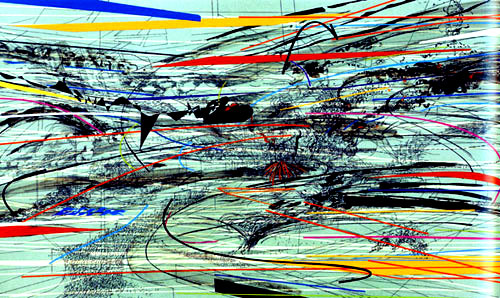
JULIE MEHRETU
"I use an imagined complex language of symbols and marks that behave, battle, migrate and socialize to create detailed maps and architectonic Plans of an artificial, abstract cosmology. I am interested in the multifaceted layers of place, space and time that impact in the Formation of personal and communal identity. My paintings question the multiplicity of history and its systems by playing with the language of symbolic geography and architecture as a tool for representing personal narratives. I have used maps of major American international airports, stadiums, arenas, schools, barracks, museums, and governmental buildings that are historically significant."
http://www.walkerart.org/programs/vaexhibjuliemehretu.html
http://www.nmafa.si.edu/exhibits/passages/mehretu.html
http://www.universes-in-universe.de/specials/africa-remix/mehretu/english.htm


LEBBEUS WOODS
"Widely considered one of the most innovative experimental architects working today, Lebbeus Woods (American, b. 1940) combines an extraordinary mastery of drawing with a penetrating analysis of architectural and urban form and social and political conditions that is nourished by his wide knowledge of fields ranging from philosophy to cybernetics. Like many architects engaged in speculation, he has produced no permanent bricks-and-mortar edifices. For Woods, however, the act of articulating ideas graphically or through the medium of the model of releasing those ideas from the realm of the mind into the real world is as constitutive of building as is the act of physical construction".
http://www.arq.upv.es/lebbeus/proyectos/zagreb.htm
http://www.arq.upv.es/lebbeus/proyectos/dmz.htm
http://www.carnegiemuseums.org/cmag/bk_issue/2004/julyaug/feature2.html
PAUL VIRILIO
"Reality is no longer defined by time and space, but in a virtual world, in which technology allows the existence of the paradox of being everywhere at the same time and being nowhere at all".
from: http://www.egs.edu/resources/virilio.html
The importance of Virilio's theoretical work stems from his central claim, that in a culture dominated by war, the military-industrial complex is of crucial significance in debates over the creation of the city and the spatial organization of cultural life. In Speed & Politics (1977) for example, Virilio offers a credible 'war model' of the growth of the modern city and the development of human society. According to Virilio, the fortified city of the feudal period was a stationary and generally unassailable 'war machine' coupled to an attempt to modulate the circulation and the momentum of the movements of the urban masses. Therefore, the fortified city was a political space of habitable inertia, the political configuration, and the physical underpinning of the feudal era. Nevertheless, for Virilio, the essential question is why did the fortified city disappear? His rather unconventional answer is that it did so due to the advent of ever-increasingly transportable and accelerated weapons systems. For such innovations 'exposed' the fortified city and transformed siege warfare into a war of movement. Additionally, they undermined the efforts of the authorities to govern the flow of the urban citizenry and therefore heralded the arrival of what Virilio calls the 'habitable circulation' of the masses. Unlike Marx, then, Virilio postulates the transition from feudalism to capitalism was not an economic transformation but a military, spatial, political, and technological metamorphosis. Broadly speaking, where Marx wrote of the materialist conception of history, Virilio writes of the military conception of history.
"The Kosovo War Took Place in Orbital Space"
http://www.cryptome.org/virilio-rma.htm
"Dromologies: Paul Virilio: Speed, Cinema, and the End of the Political State"
